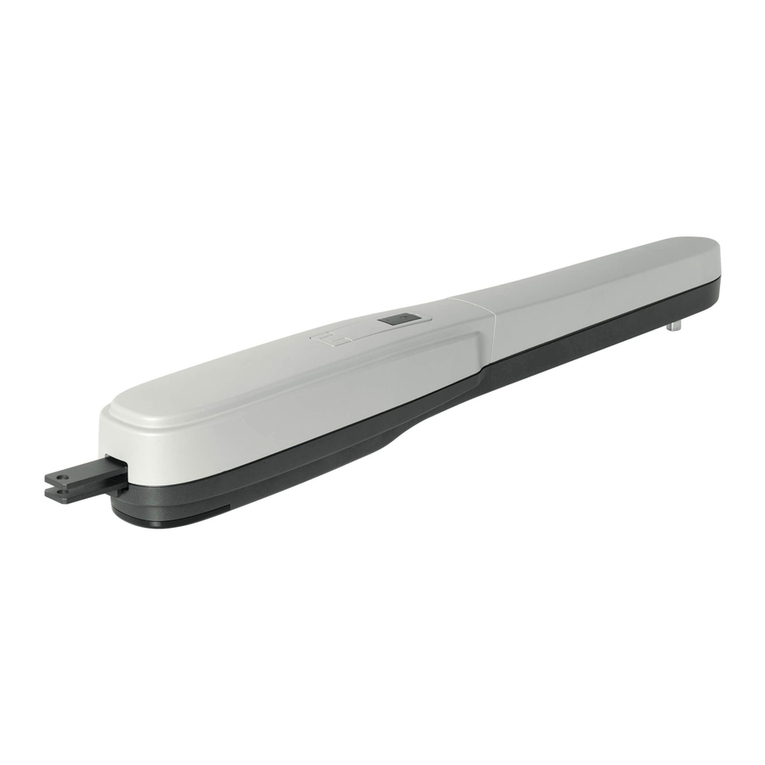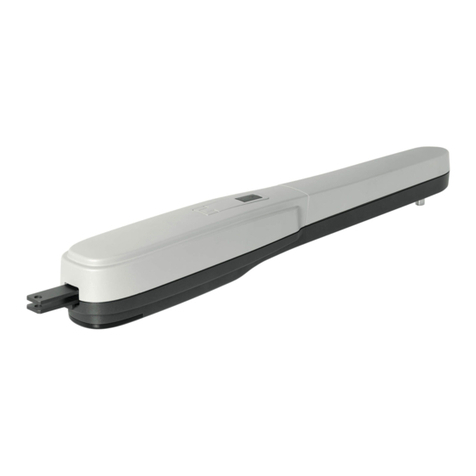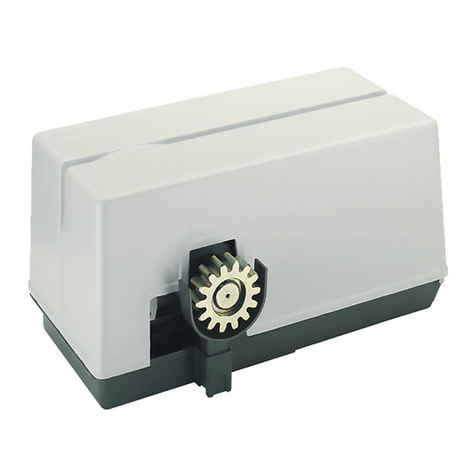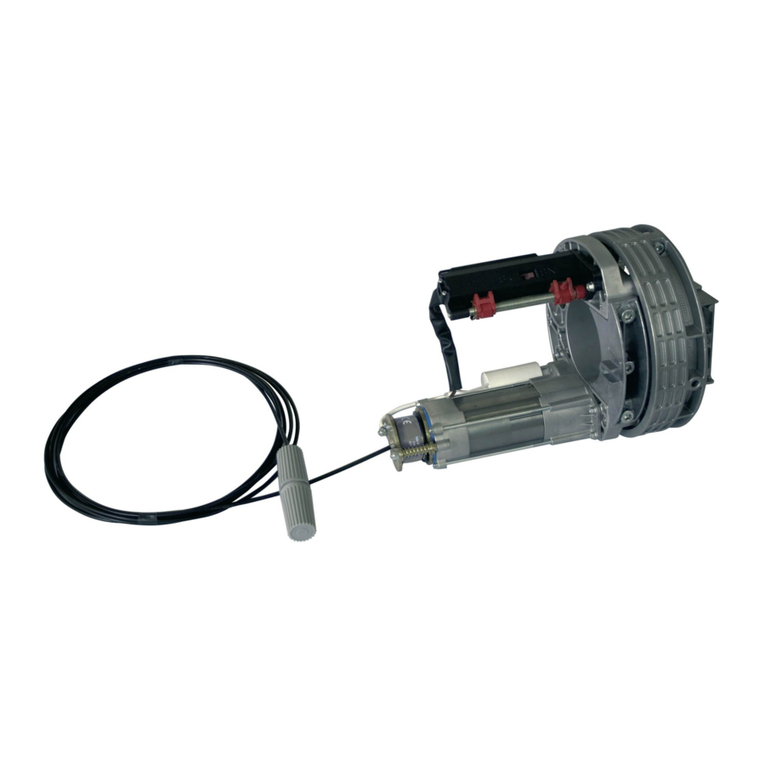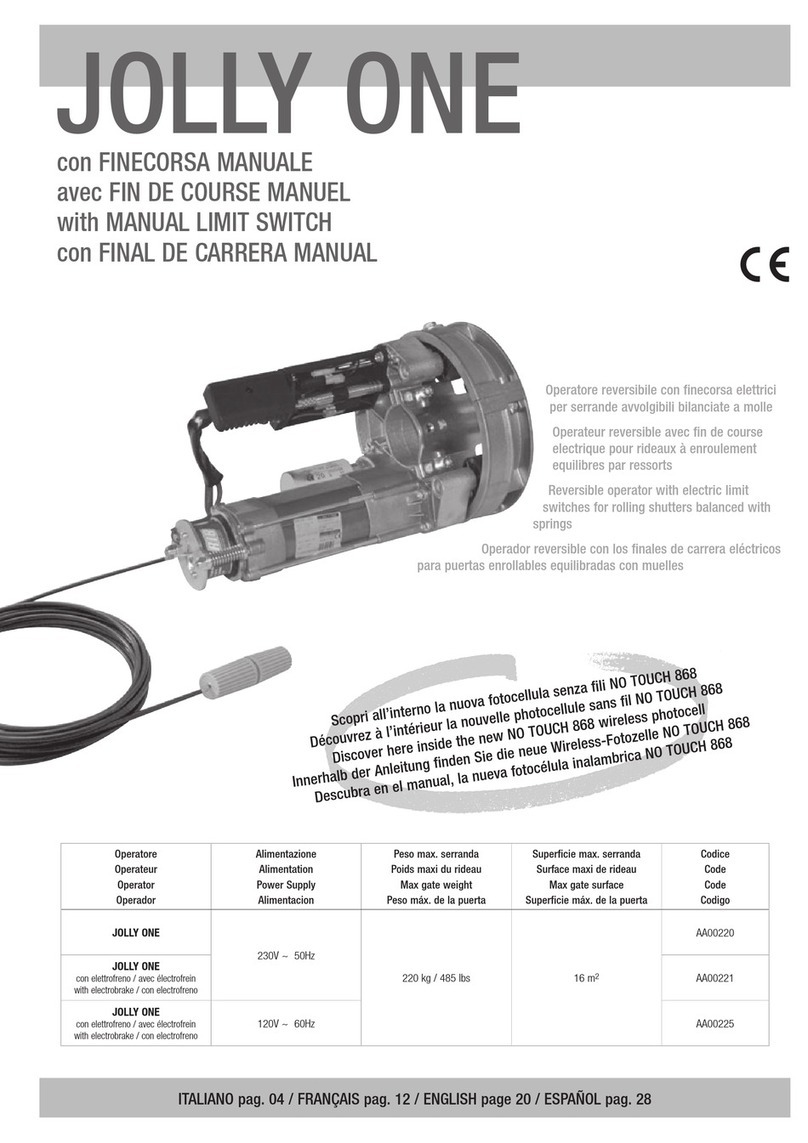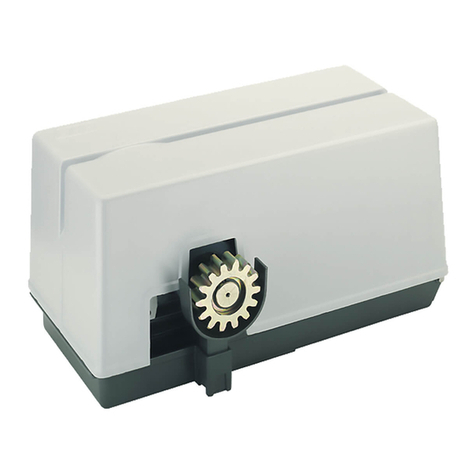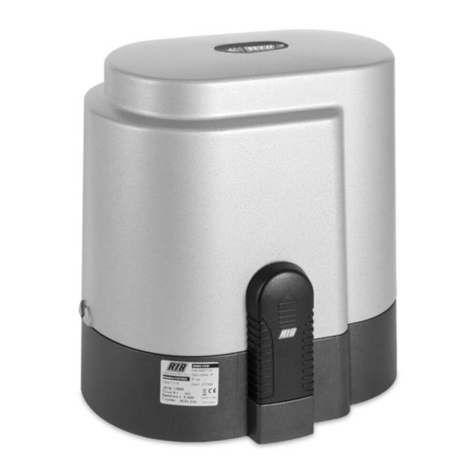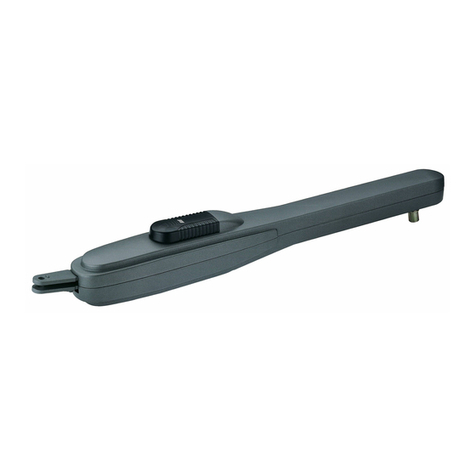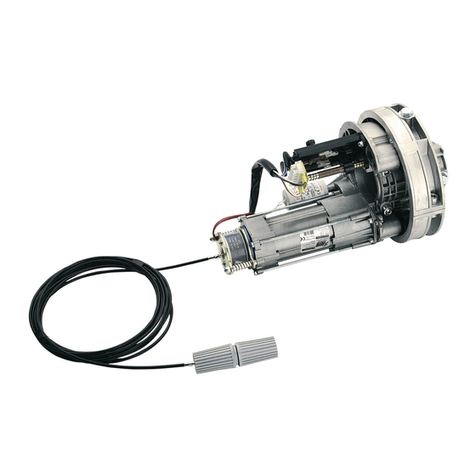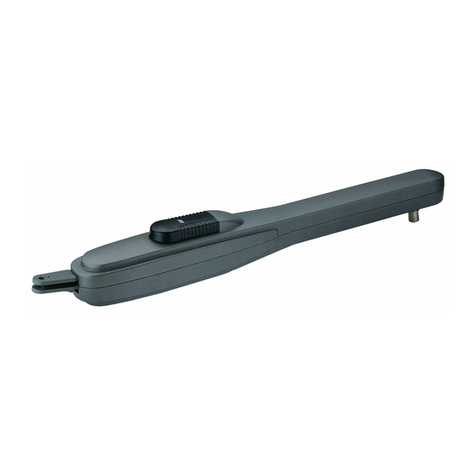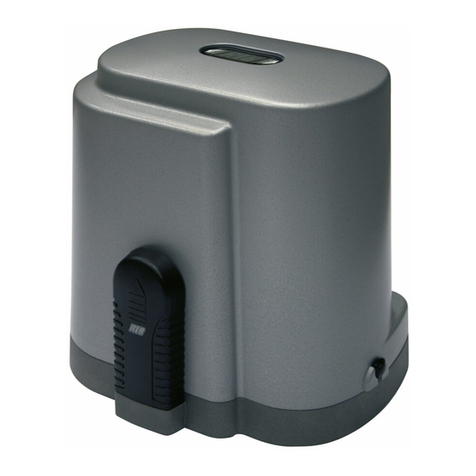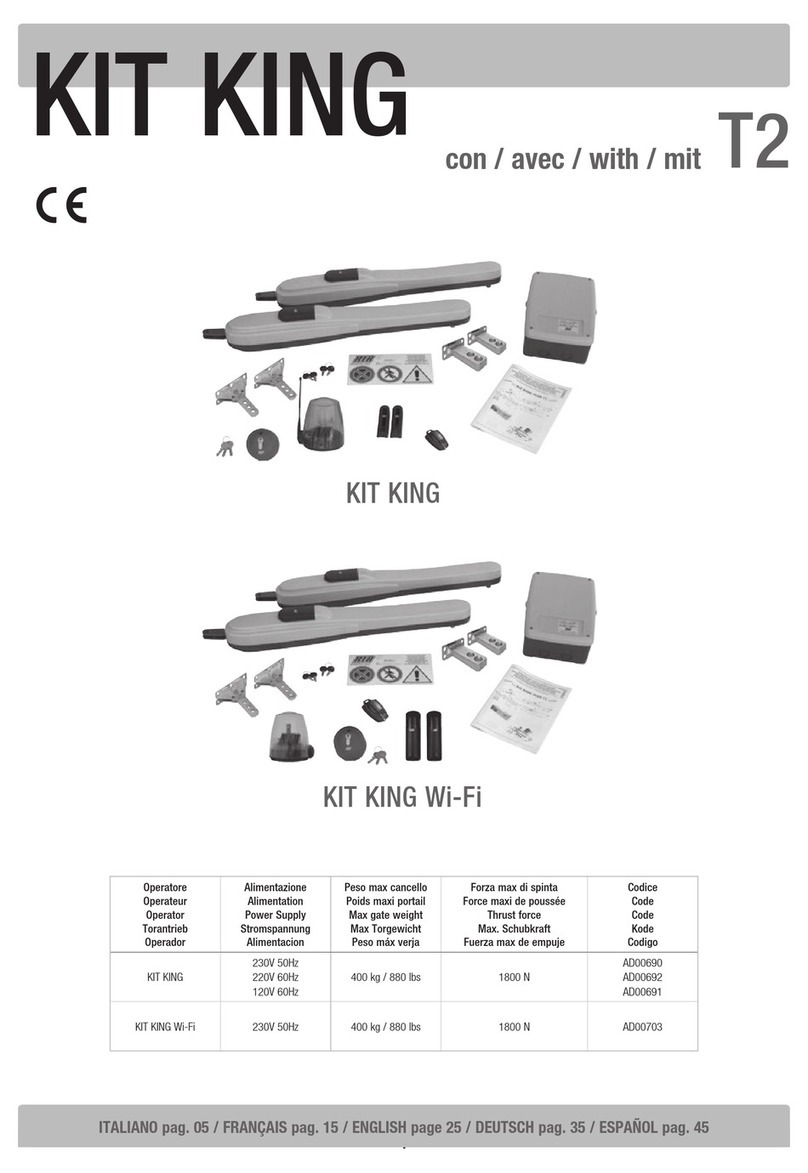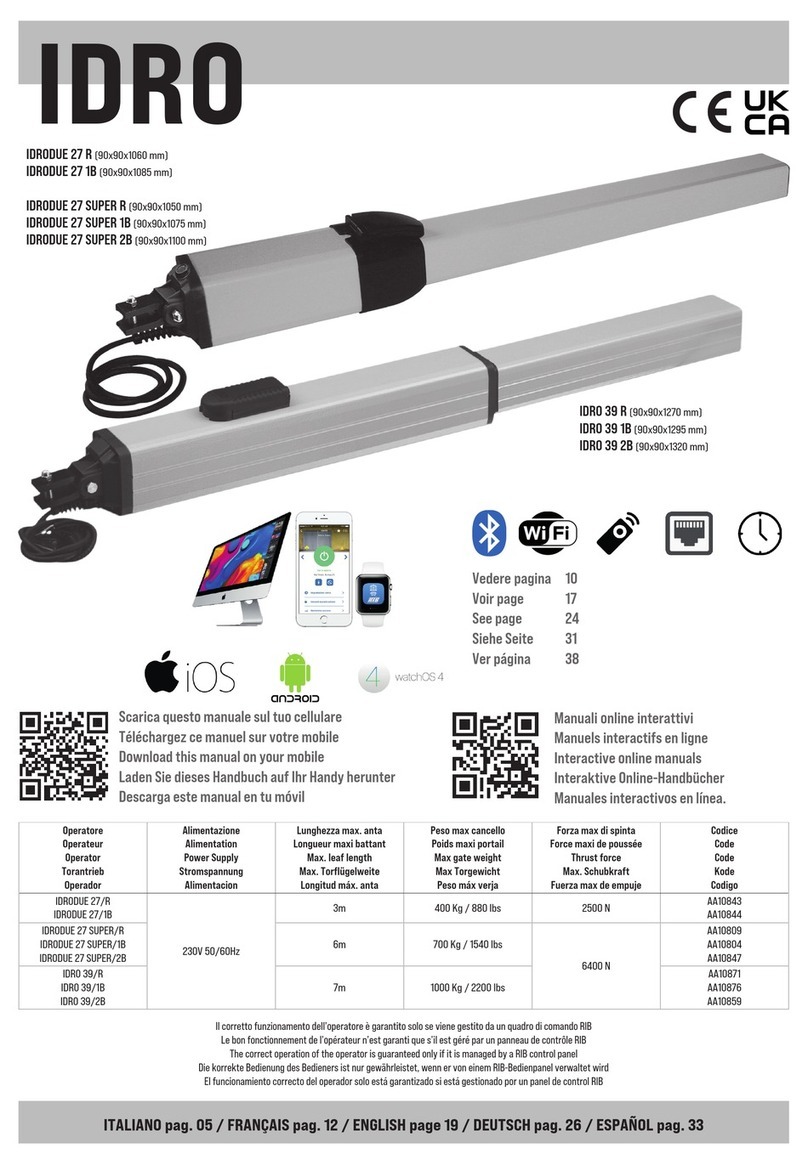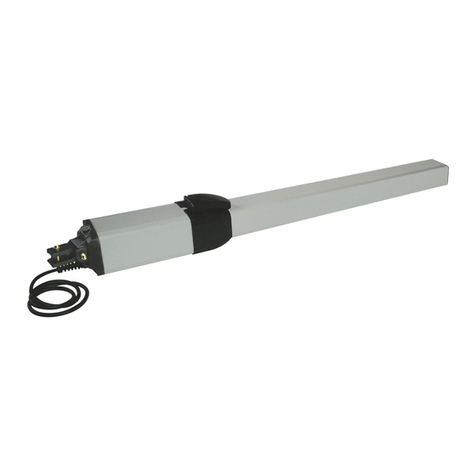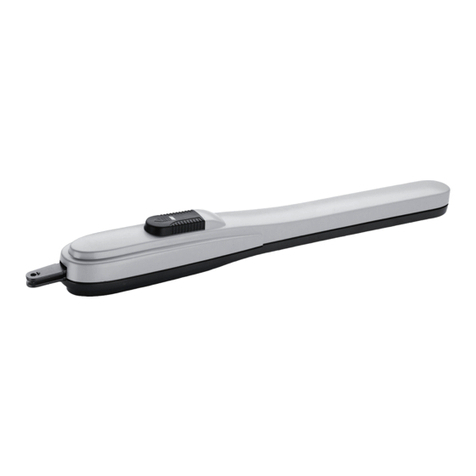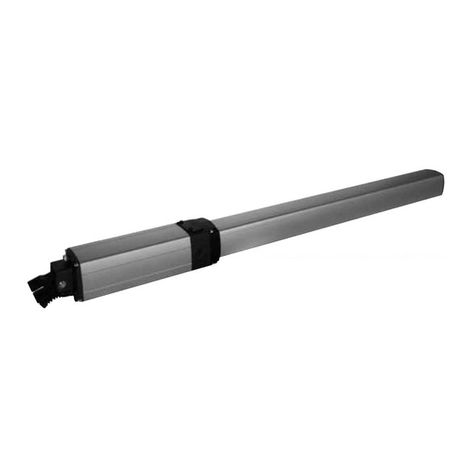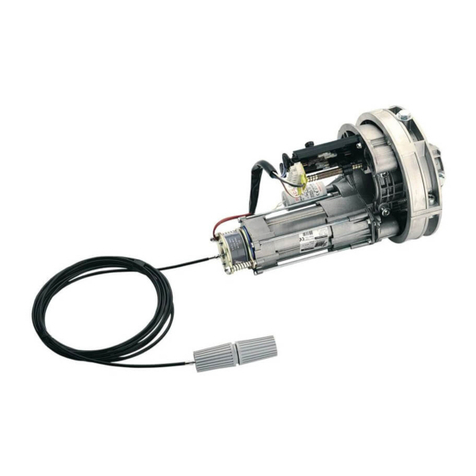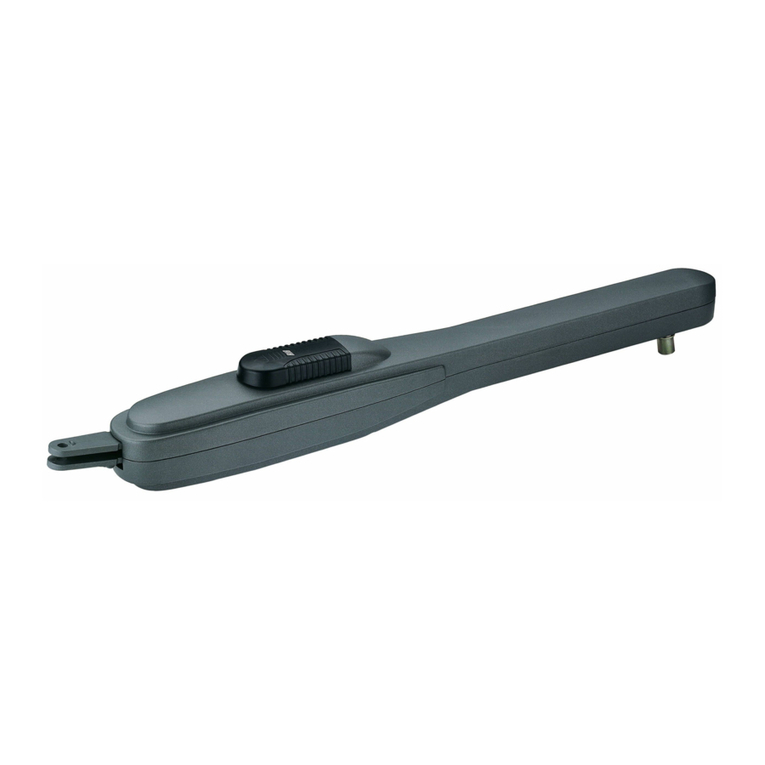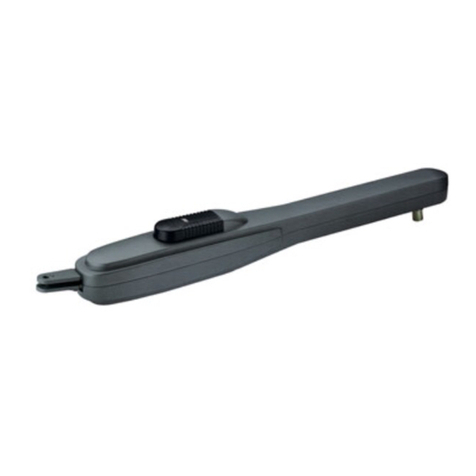
Pag. 10 di 28
MONTAGE COMET S sur PORTE SECTIONNELLE
ou PORTE BASCULANTE EQUILIBREE AVEC RESSORTS
(avec group de traction optionelle code ACG8203)
1-Retirer l’opérateur de la boîte et le poser sur le sol (Fig.1).
ATTENTION: LES RAILS ET LA CHAINES NE DOIVENT EN AUCUN CAS ETRE COUPÉS OU
MODIFIÉS PAR L'INSTALLATEUR, MEME SI LA LONGUEUR DE COURSE EST PLUS
IMPORTANTE QUE NÉCESAIRE. POSITIONNER DE FAÇON APPROPRIÉE LA BUTÉE
MÉCANIQUE, ET N'EFFECTUER AUCUNE MODIFICATION SUR LE PRODUIT.
2-Prendre le guide central (il a un trou au centre sur les deux côtés).
3-Insérer les deux petits plats filetés dans les gorges en correspondance avec les trous.
4 - Prendre 2 étriers de fixation au plafond et les visser au guide avec vis et rondelles comme
figures 2-3-4-5.
5 - Insérer un profil de connexion guides en le faisant dépasser d’environ 10 cm du guide de tête
(Fig.6).
6 - Le fixer avec une des vis autotaraudeuses 4,2x13 fournies (Fig.7).
7 - Insérer la chaîne dans le guide central en faisant attention au canal que l’on choisit pour
l’insertion (Fig. 8-9)
ATTENTION : NE PAS GRAISSER LA CHAINE !
8-Serrer le guide central sur le profil avec une vis 4,2x13 comme figures 10 et 11.
ATTENTION : FIXER LES DEUX VIS SUR LE MEME COTE !
9 - Visser les 2 autres vis sur le côté opposé en vérifiant que les deux profils ne soient pas
séparés l’un de l’autre (Fig.12-13).
10 - Insérer le second profil de connexion et procéder comme indiqué du point 5 au point 11 (Fig.
14-15-16-17-18-19-20-21).
11 - Prendre l’attache antérieure et l’utiliser pour déterminer les entraxes des trous de fixation
dans le mur (22-23-24).
ATTENTION : 5cm est la mesure de la distance minimum à maintenir entre le guide du COMET
Set la porte ouverte au point de distance minimum du plafond.
13 - Après avoir effectué les trous dans le mur, visser l’attache antérieure au guide de queue en
utilisant les deux petits plats filetés et le vis avec rondelles (Fig.25-26-27-28-29-30).
14 - Poser l’attache antérieure au mur à proximité des trous de fixation.
ATTENTION : Positionner un chiffon entre le sol et le carter de l’opérateur pour éviter que celui-ci
ne s’abîme. (Fig.31-32).
15 - Une fois l’attache antérieure fixée avec les vis fournies, prendre une échelle et y poser la tête
de l’opérateur (Fig.33).
16 - Fixer l’opérateur au plafond en utilisant les étriers et les vis à expansion fournis.
17 - Vérifier avec un niveau que le guide soit parfaitement horizontal (Fig.34).
18 - Fixer l’attache au centre de la porte sectionnelle (Fig.35-36).
19 - Relier l’attache au chariot de l’opérateur avec les vis, les rondelles et les écrous à blocage
automatique fournis (Fig.37).
20 - Attacher le fil et le pommeau de décrochage au levier de décrochage du chariot (régler la
longueur du fil de façon à ce que le pommeau ne touche pas un éventuel véhicule garé au-
dessous de celui-ci).
DEBLOCAGE D’URGENCE
21 - Pour éviter d'endommager le dispositif, le chariot doit être libéré par une traction verticale
vers le bas sur la cordelette (NE PAS TIRER TRANSVERSALEMENT!) (fig.38).
Pour l'utilisation du debrayage de l'extérieur et eviter de tirer transversalement, utiliser
l'accessoire de DEBRAYAGE COMET avec cable à fixer sur la serrure existante (code ACZ9011).
Pour pouvoir exécuter sûrement le mouvement manuel du battant, il faut vérifier que :
-il y ait des poignées adéquates sur la porte ;
-ces poignées soient placées de manière à ne pas créer de dangers durant leur utilisation;
-l’effort manuel pour déplacer la porte ne dépasse pas les 225N pour les portes placées sur les
sites privés et les 390N pour les portes placées sur des sites commerciaux et industriels (valeurs
indiquées au point 5.3.5 de la norme EN 12453).
ATTENTION :La mise en marche du déblocage peut provoquer un mouvement non contrôlable
de la porte au cas où celle-ci ne soit pas correctement équilibrée.
22 - SEULEMENT LORSQUE LE CHARIOT EST DECROCHE, TIRER TRANSVERSALEMENT
LA CORDE pour ouvrir la porte (Fig. 39) et vérifier qu’elle ne touche en aucun cas le guide,
durant tout le déplacement.
REGLAGE BUTEE MECANIQUE
23 - Quand le chariot est décroché, ouvrir la porte.
24 - Desserrer les vis de la butée mécanique et la faire glisser le long du guide jusqu’à son arrivée
en butée contre le chariot (Fig. 52).
25 - Une fois positionnée, serrer les vis avec force pour en fixer la position.
ATTENTION: APRES CHAQUE DÉPLACEMENT DE LA POSITION DE LA BUTÉE, IL SERA
NÉCESSAIRE DE REFAIRE LA PROGRAMMATION DE LA COURSE. Celle ci
pourra être répétée autant de fois que désiré.
BRANCHEMENTS ELECTRIQUES
26 - Retirer le carter en dévissant la vis filetée et en agissant sur les attelages latéraux (Fig.40).
27 - Exécuter les branchements électriques et visser l’ampoule fournie (seulement modèles 230V
50/60Hz)
28 - Effectuer les settages et la programmation de la centrale en suivant les procédures
appropriées à cet effet, illustrées dans les pages suivantes.
29 - Remonter le carter sur l’opérateur (Fig. 42-43-44-45).
MONTAGE COMET S sur PORTE BASCULANTE
EQUILIBREE A CONTREPOIDS
(avec Bras adaptateur en option code ACG8201)
1-Retirer l’opérateur de la boîte et le poser sur le sol (Fig.1).
ATTENTION: LES RAILS ET LA CHAINES NE DOIVENT EN AUCUN CAS ETRE COUPÉS OU
MODIFIÉS PAR L'INSTALLATEUR, MEME SI LA LONGUEUR DE COURSE EST PLUS
IMPORTANTE QUE NÉCESAIRE. POSITIONNER DE FAÇON APPROPRIÉE LA BUTÉE
MÉCANIQUE, ET N'EFFECTUER AUCUNE MODIFICATION SUR LE PRODUIT.
2-Prendre le guide central (il a un trou au centre sur les deux côtés).
3-Insérer les deux petits plats filetés dans les gorges en correspondance avec les trous.
4 - Prendre 2 étriers de fixation au plafond et les visser au guide avec vis et rondelles comme
figures 2-3-4-5)
5 - Insérer un profil de connexion guides en le faisant dépasser d’environ 10 cm du guide de tête (Fig.6).
6-Le fixer avec une des vis autotaraudeuses 4,2x13 fournies (Fig.7).
7 - Insérer la chaîne dans le guide central en faisant attention au canal que l’on choisit pour
l’insertion (Fig. 8-9)
ATTENTION : NE PAS GRAISSER LA CHAINE !
8-Serrer le guide central sur le profil avec une vis 4,2x13 comme figures 10 et 11.
ATTENTION : FIXER LES DEUX VIS SUR LE MEME COTE !
9 - Visser les 2 autres vis sur le côté opposé en vérifiant que les deux profils ne soient pas
séparés l’un de l’autre (Fig.12-13).
10 - Insérer le second profil de connexion et procéder comme indiqué du point 5 au point 11 (Fig.
14-15-16-17-18-19-20-21).
11 - Prendre l’attache antérieure et l’utiliser pour déterminer les entraxes des trous de fixation
dans le mur (22-23-24).
ATTENTION : 5cm est la mesure de la distance minimum à maintenir entre le guide du COMET
Set la porte ouverte au point de distance minimum du plafond.
13 - Après avoir effectué les trous dans le mur, visser l’attache antérieure au guide de queue en
utilisant les deux petits plats filetés et le vis avec rondelles (Fig.25-26-27-28-29-30).
14 - Poser l’attache antérieure au mur à proximité des trous de fixation.
ATTENTION : Positionner un chiffon entre le sol et le carter de l’opérateur pour éviter que celui-ci
ne s’abîme. (Fig.31-32).
15 - Une fois l’attache antérieure fixée avec les vis fournies, prendre une échelle et y poser la tête
de l’opérateur (Fig.33).
16 - Fixer l’opérateur au plafond en utilisant les étriers et les vis à expansion fournis.
17 - Vérifier avec un niveau que le guide soit parfaitement horizontal (Fig.34).
18 - Fixer le bras adaptateur au centre de la porte basculante (Fig.46-47-48).
ATTENTION :La garantie de l’opérateur est annulée au cas où l’attache antérieure soit appliquée
dans une position différente de celle du centre de la porte.
19 - Relier l’attache au chariot de l’opérateur avec les vis, les rondelles et les écrous à blocage
automatique fournis (Fig.37).
20 - Attacher le fil et le pommeau de décrochage au levier de décrochage du chariot (régler la
longueur du fil de façon à ce que le pommeau ne touche pas un éventuel véhicule garé au-
dessous de celui-ci).
DEBLOCAGE D’URGENCE
21 - Pour éviter d'endommager le dispositif, le chariot doit être libéré par une traction verticale
vers le bas sur la cordelette (NE PAS TIRER TRANSVERSALEMENT!) (fig.38).
Pour l'utilisation du debrayage de l'extérieur et eviter de tirer transversalement, utiliser
l'accessoire de DEBRAYAGE COMET avec cable à fixer sur la serrure existante (code ACZ9011).
Pour pouvoir exécuter sûrement le mouvement manuel du battant, il faut vérifier que :
-il y ait des poignées adéquates sur la porte ;
-ces poignées soient placées de manière à ne pas créer de dangers durant leur utilisation;
-l’effort manuel pour déplacer la porte ne dépasse pas les 225N pour les portes placées sur les
sites privés et les 390N pour les portes placées sur des sites commerciaux et industriels (valeurs
indiquées au point 5.3.5 de la norme EN 12453).
ATTENTION :La mise en marche du déblocage peut provoquer un mouvement non contrôlable
de la porte au cas où celle-ci ne soit pas correctement équilibrée.
22 - SEULEMENT LORSQUE LE CHARIOT EST DECROCHE, TIRER TRANSVERSALEMENT
LA CORDE pour ouvrir la porte (Fig. 39) et vérifier qu’elle ne touche en aucun cas le guide,
durant tout le déplacement.
REGLAGE BUTEE MECANIQUE
23 - Quand le chariot est décroché, ouvrir la porte en la laissant légèrement baissée une fois
qu’elle a accompli l’ouverture (Fig. 51).
24 - Desserrer les vis de la butée mécanique et la faire glisser le long du guide jusqu’à son arrivée
en butée contre le chariot (Fig. 52).
25 - Une fois positionnée, serrer les vis avec force pour en fixer la position.
ATTENTION: APRES CHAQUE DÉPLACEMENT DE LA POSITION DE LA BUTÉE, IL SERA
NÉCESSAIRE DE REFAIRE LA PROGRAMMATION DE LA COURSE. Celle ci
pourra être répétée autant de fois que désiré.
BRANCHEMENTS ELECTRIQUES
26 - Retirer le carter en dévissant la vis filetée et en agissant sur les attaches latérales (Fig.40).
27 - Exécuter les branchements électriques et visser l’ampoule fournie (seulement modèles 230V
50/60Hz)
28 - Effectuer les settages et la programmation de la centrale en suivant les procédures
appropriées à cet effet, illustrées dans les pages suivantes.
29 - Remonter le carter sur l’opérateur (Fig. 42-43-44-45).
F
R
A
N
Ç
A
I
S
E






